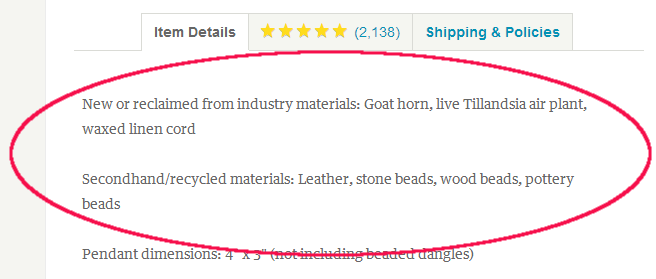If you’ve visited my Etsy shop lately, you may have noticed that I’ve made some changes to how I describe the materials used in my works. In my continuing efforts to be more eco-friendly in my art, and to help prospective buyers make decisions that fit their personal ethics, I’ve divided the materials up into two categories:
New or reclaimed from industry materials: “New” describes supplies that I’ve either bought new from a shop or a commercial supplier, like certain jewelry findings, most acrylic paints, and artificial sinew and other thread. “Reclaimed from industry” is sort of the “pre-consumer waste” alternative–it includes scraps from commercial industries that I then reclaim myself or through a third party supplier. These are usually byproducts that the original industry can’t use, but which are kept out of the waste stream (read: the trash) through art and other means. A good example would be the tails and other scrap fur that are left over from garment manufacture.
Secondhand/recycled materials: Secondhand refers to materials that previously belonged to another private individual; this can range from hides and bones that were a part of a person’s private collection, to leather jackets, costume jewelry and other items from thrift stores, yard sales and the like. Recycled materials are things that I’ve otherwise repurposed; for example, handmade paper made from envelopes, unwanted junk mail, and other paper that I would have tossed into the recycling bin otherwise.
As both a mixed-media artist and an avid environmentalist, I feel very strongly that it’s my job to promote eco-friendly practices and materials. Over the years I’ve incorporated more and more green habits into both my art and my everyday life, and I want to encourage others to consider doing the same. By being more transparent and straightforward about where my supplies come from, I hope to inspire people to think more about where the items they’re buying come from, not just art, but in general. Look at the plastic and cardboard packaging that much of our food is wrapped in. You may see a label that says “Made with 75% post-consumer waste” on it, but have you ever really thought about what that means? For me, at least, it’s incentive to keep supporting companies that make use of recycled fibers and other materials, to be extra-careful about sorting out my recyclables, and to reduce my consumption in the first place.
And I want to do that with my art as well. My creations are intended to evoke honor and care for the environment, and by being more clear about the origin of my materials, I am not only offering up the information to others, but I’m also reminding myself of where the things I make things out of come from. As I spent the past couple of weeks updating each of over 300 listings in my shop, I became a lot more aware of the realistic proportions of new to secondhand materials I was working with. Sometimes I was surprised at how little secondhand stuff was in one piece; other times I’d find a piece that was entirely made of reclaimed materials. It’s not that I wasn’t conscious of my materials on some level before, but this exercise brought it into greater awareness. And it’ll keep happening each time I list new items and go through the process of describing the materials in detail.
Of course, just as the 75% post-consumer waste cardboard cracker box doesn’t tell you the whole story–the pollutants that are a result of even the most efficient recycling process, the energy used to make the box and fill it with stuff and truck it to the store–my brief descriptions aren’t the whole story, either. For example, I’m well aware that commercial tanning is a messy process with nasty byproducts, and that although acrylic paint is a much more eco-friendly product than oil paint, it’s not without toxins in its process, either (plus you can’t really clean the bottle well enough to recycle it). That’s part of why I’ve always maintained an open-door policy when it comes to questions about my materials and their sources. I’m happy to explain to the best of my knowledge where something comes from and what its impact is.
I still have a list of changes I want to make to my materials and my processes that are more in line with my environmental ethics. Some of them are out of reach right now because I don’t have the money or space, or because I haven’t had the time to experiment with greener alternatives (or I haven’t found one that fits my needs). But, like anyone, I do the best I can with what I have. I may still be renting from a fairly strict property management company and therefore can’t install solar panels, but my local electric company offers a 100% green energy plan with additional salmon habitat restoration, and I switched over to it a few years ago.
And I’ll keep knocking things off my “green list” as I go along. This shift in my materials descriptions is a small thing, but I hope it helps. Here’s an example of where you can find the materials information on each listing:
Please note that I did not include this on items in my Supplies/Vintage category, since for the most part those aren’t items I made myself. I also didn’t include it on the books I’ve written, since I didn’t make the physical books themselves, and it’s not on the custom work available because each custom piece may include a unique proportion of new to secondhand materials. That being said, you can find the new materials information on the majority of the items in my shop, and again you’re always welcome to ask me about sourcing.



